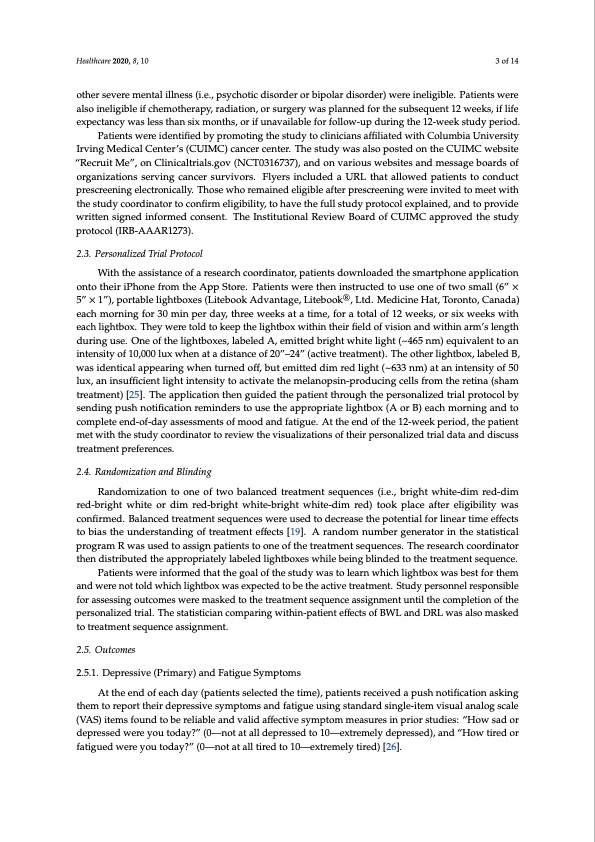
PDF Publication Title:
Text from PDF Page: 003
Healthcare 2020, 8, 10 3 of 14 other severe mental illness (i.e., psychotic disorder or bipolar disorder) were ineligible. Patients were also ineligible if chemotherapy, radiation, or surgery was planned for the subsequent 12 weeks, if life expectancy was less than six months, or if unavailable for follow-up during the 12-week study period. Patients were identified by promoting the study to clinicians affiliated with Columbia University Irving Medical Center’s (CUIMC) cancer center. The study was also posted on the CUIMC website “Recruit Me”, on Clinicaltrials.gov (NCT0316737), and on various websites and message boards of organizations serving cancer survivors. Flyers included a URL that allowed patients to conduct prescreening electronically. Those who remained eligible after prescreening were invited to meet with the study coordinator to confirm eligibility, to have the full study protocol explained, and to provide written signed informed consent. The Institutional Review Board of CUIMC approved the study protocol (IRB-AAAR1273). 2.3. Personalized Trial Protocol With the assistance of a research coordinator, patients downloaded the smartphone application onto their iPhone from the App Store. Patients were then instructed to use one of two small (6” × 5” × 1”), portable lightboxes (Litebook Advantage, Litebook®, Ltd. Medicine Hat, Toronto, Canada) each morning for 30 min per day, three weeks at a time, for a total of 12 weeks, or six weeks with each lightbox. They were told to keep the lightbox within their field of vision and within arm’s length during use. One of the lightboxes, labeled A, emitted bright white light (~465 nm) equivalent to an intensity of 10,000 lux when at a distance of 20”–24” (active treatment). The other lightbox, labeled B, was identical appearing when turned off, but emitted dim red light (~633 nm) at an intensity of 50 lux, an insufficient light intensity to activate the melanopsin-producing cells from the retina (sham treatment) [25]. The application then guided the patient through the personalized trial protocol by sending push notification reminders to use the appropriate lightbox (A or B) each morning and to complete end-of-day assessments of mood and fatigue. At the end of the 12-week period, the patient met with the study coordinator to review the visualizations of their personalized trial data and discuss treatment preferences. 2.4. Randomization and Blinding Randomization to one of two balanced treatment sequences (i.e., bright white-dim red-dim red-bright white or dim red-bright white-bright white-dim red) took place after eligibility was confirmed. Balanced treatment sequences were used to decrease the potential for linear time effects to bias the understanding of treatment effects [19]. A random number generator in the statistical program R was used to assign patients to one of the treatment sequences. The research coordinator then distributed the appropriately labeled lightboxes while being blinded to the treatment sequence. Patients were informed that the goal of the study was to learn which lightbox was best for them and were not told which lightbox was expected to be the active treatment. Study personnel responsible for assessing outcomes were masked to the treatment sequence assignment until the completion of the personalized trial. The statistician comparing within-patient effects of BWL and DRL was also masked to treatment sequence assignment. 2.5. Outcomes 2.5.1. Depressive (Primary) and Fatigue Symptoms At the end of each day (patients selected the time), patients received a push notification asking them to report their depressive symptoms and fatigue using standard single-item visual analog scale (VAS) items found to be reliable and valid affective symptom measures in prior studies: “How sad or depressed were you today?” (0—not at all depressed to 10—extremely depressed), and “How tired or fatigued were you today?” (0—not at all tired to 10—extremely tired) [26].PDF Image | Bright White Light Therapy for Depression in Cancer Survivors

PDF Search Title:
Bright White Light Therapy for Depression in Cancer SurvivorsOriginal File Name Searched:
healthcare-08-00010.pdfDIY PDF Search: Google It | Yahoo | Bing
Cruise Ship Reviews | Luxury Resort | Jet | Yacht | and Travel Tech More Info
Cruising Review Topics and Articles More Info
Software based on Filemaker for the travel industry More Info
The Burgenstock Resort: Reviews on CruisingReview website... More Info
Resort Reviews: World Class resorts... More Info
The Riffelalp Resort: Reviews on CruisingReview website... More Info
| CONTACT TEL: 608-238-6001 Email: greg@cruisingreview.com | RSS | AMP |